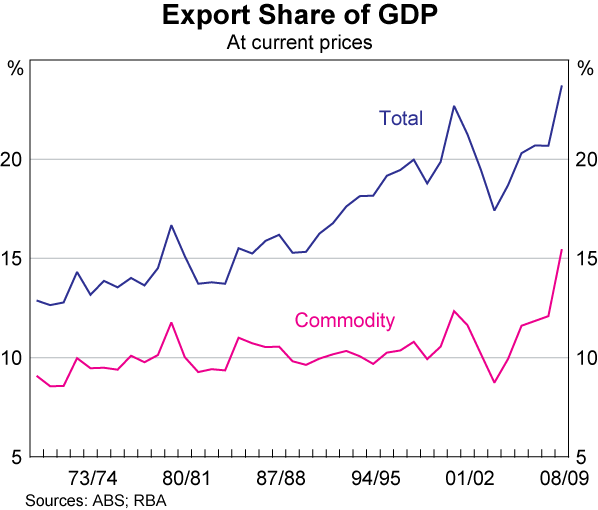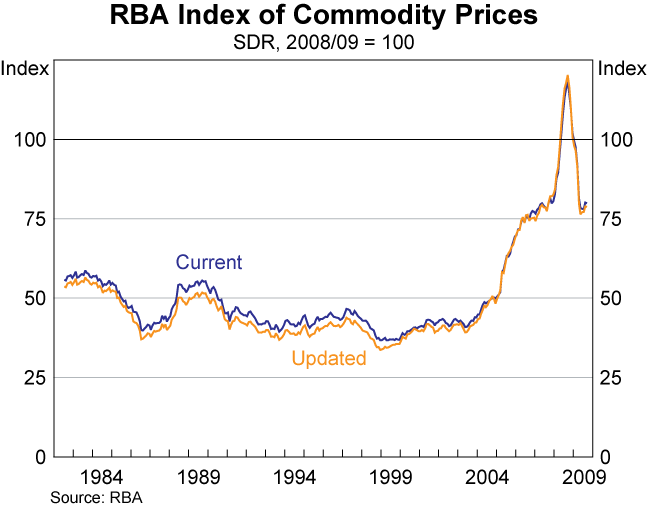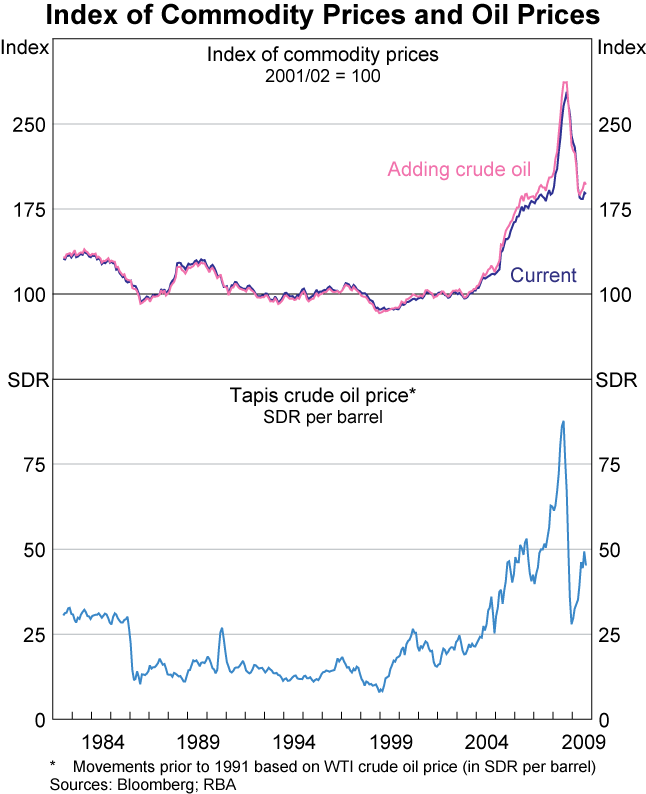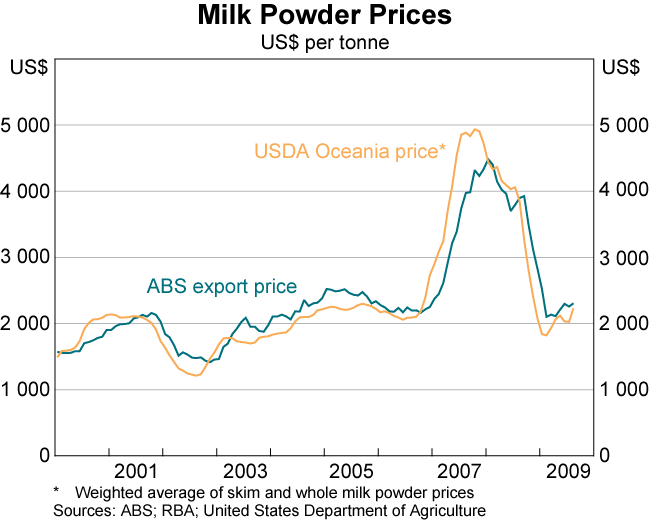Bulletin – October 2009 Updating the RBA's Index of Commodity Prices[1]
- Download 158KB
Introduction
This article outlines the results of a recent review by RBA staff of the Bank's monthly Index of Commodity Prices (ICP). The ICP provides a timely indicator of the prices received by Australian commodity exporters. With exports now equivalent to almost 25 per cent of GDP, developments in export prices can have a significant influence on economic activity (Graph 1). In recent years, the importance of commodities in Australia's total exports has increased, due in part to the rapid industrialisation of emerging economies in Asia.[2]

The ICP is a Laspeyres index, which means that the index is a weighted average of recent changes in commodity prices.[3] While the initial weight given to each commodity reflects its relative importance in total commodity export earnings in the base period, at any point in time thereafter the effective weight of each commodity in the index reflects the impact of subsequent changes in its price. However, since export values change as a result of movements in quantities exported as well as changes in prices, it is necessary to update periodically the base-period weights to reflect changes in export volumes. In addition, since the importance of individual commodities in Australia's export values changes over time – with the weight of some commodities becoming very small while others rise in importance – it is necessary to periodically review the commodities that are included in the index.
RBA staff have recently completed such a review, updating that conducted in 2003. As a result, starting with the release of the ICP for October on 2 November 2009, the following changes will be made:
- the ICP will be re-based from 2001/02 to 2008/09;
- crude oil will be reintroduced to the index and the whole history of the ICP back-cast accordingly; and
- milk powder will be added and rice will be excluded from the index, back-cast to July 2008.
The updated index will include the prices of 20 of Australia's key commodity exports, which currently account for around 85 per cent of primary commodity export earnings. The re-basing to 2008/09 and addition of crude oil have a noticeable effect on the weights of each sub-index and individual commodity; adding milk powder and excluding rice have only small effects on the ICP.
Graph 2 compares the updated index with the current index. The updated ICP still reflects the sharp run-up in commodity prices from 2004, peaking in September 2008 and subsequently retracing a substantial proportion of these gains. The run-up is slightly more pronounced in the updated index, reflecting the greater weight given to iron ore and coal and the inclusion of crude oil prices.

Changes to the Coverage of the Index
Crude oil is not currently included in the ICP, in part because Australia is a net importer of petroleum products.[4] Australia does, however, export crude oil, which accounts for around 5 per cent of Australia's commodity export receipts. Given this relatively important role, crude oil will be reintroduced to the ICP using the Tapis crude oil price, which reflects the prices achieved for Australian crude oil exports more closely than other major exchange-traded oil contracts.[5] The history of the ICP index will be back-cast to July 1982 to reflect this inclusion of crude oil prices (Graph 3).

Milk powder will also be added to the ICP. While many dairy goods have a significant manufactured component, some products, such as non-enriched milk powder, have characteristics that more closely resemble a commodity. In recent years, non-enriched milk powders accounted for around 1 per cent of Australia's total commodity exports and 4 per cent of rural exports (in value terms). While the ABS has monthly export price data for this product, fortnightly data on Oceania milk powder prices are available from the United States Department of Agriculture (Graph 4).[6] Since this series moves in line with Australian export price data, is more timely and is available at a higher frequency, it will be used to construct the ICP.

The importance of rice as a source of export income has been in decline for a number of years, and now accounts for less than ¼ per cent of Australia's commodity exports. Incorporating more recent export weights in the ICP would have further reduced the influence that rice prices have on the overall index. Since even very large movements in the price of rice would now have only a negligible effect on the index, rice will be excluded starting from July 2008.
Re-basing the ICP
The weight given to each commodity included in the ICP currently reflects its share of export volumes in 2001/02 and the impact of subsequent price changes on export values. Ideally, the base year for the new weights would be representative of the current and future structure of exports. For this reason, weights based on export values in 2008/09 have been selected for the updated ICP, to capture the structural increase in resource export volumes since 2001/02 and avoid the drought-affected rural export volumes in 2006/07 and 2007/08.
Table 1 shows the current and updated weights for the commodity exports included in the ICP. It also shows implied effective weights for September 2009, which reflect the extent to which the current value of the index already incorporates changes to export prices that have already occurred since 2008/09. With the new weights, the relative importance of ‘other resources’ has increased substantially compared with the weights based on export values in 2001/02. These components, which include metal ores, gold and energy commodities, now account for around 75 per cent of the index, and more than 80 per cent once crude oil is also included. The weight of the rural commodities included in the ICP has declined to around 10 per cent from around 30 per cent in 2001/02, and the weights of the base metals included have also declined. These reductions mainly reflect the more moderate pace of growth in export volumes in rural commodities and base metals compared with other resource commodities since 2001/02, as well as the introduction of crude oil prices into the ICP.
| Current index weights | Updated index weights | |||
|---|---|---|---|---|
|
Initial 2001/02 |
Effective 2008/09 |
Initial 2008/09 |
Effective Sep 2009 |
|
| Rural commodities | 29.1 | 17.1 | 10.3 | 12.5 |
| Beef and veal | 7.9 | 4.1 | 3.2 | 4.1 |
| Wheat | 8.3 | 5.3 | 3.2 | 2.9 |
| Wool | 4.1 | 2.0 | 1.1 | 1.6 |
| Milk powder | – | – | 0.8 | 1.0 |
| Sugar | 2.5 | 1.6 | 0.7 | 1.5 |
| Barley | 1.9 | 1.3 | 0.6 | 0.6 |
| Canola | 1.0 | 0.7 | 0.4 | 0.5 |
| Cotton | 2.8 | 1.5 | 0.3 | 0.4 |
| Rice | 0.5 | 0.7 | – | – |
| Base metals | 15.7 | 10.8 | 6.8 | 9.6 |
| Aluminium | 8.1 | 3.9 | 3.4 | 4.1 |
| Copper | 2.8 | 3.1 | 1.8 | 2.8 |
| Lead | 0.7 | 0.8 | 0.6 | 1.2 |
| Zinc | 1.5 | 0.9 | 0.6 | 1.0 |
| Nickel | 2.6 | 2.0 | 0.4 | 0.6 |
| Other resources | 55.3 | 72.1 | 82.9 | 77.9 |
| Metallurgical coal | 14.7 | 28.1 | 23.3 | 15.9 |
| Iron ore | 9.3 | 15.1 | 21.8 | 20.8 |
| Thermal coal | 9.7 | 10.7 | 11.4 | 9.8 |
| Gold | 9.4 | 10.0 | 10.8 | 15.1 |
| LNG | 4.8 | 3.9 | 6.5 | 5.1 |
| Crude oil | – | – | 5.3 | 7.3 |
| Alumina | 7.4 | 4.3 | 3.8 | 3.8 |
|
Sources: ABS; RBA |
||||
Real-time Data Availability
The ICP is published on the first business day of the month, and some price data are not available at the time of publication. Hence, as has been the case for some time, initial price estimates for some major commodity exports are used in the ICP and subsequently revised once final data are available. In particular, for metallurgical coal, thermal coal and iron ore, spot price or other market information is used to make preliminary estimates before monthly average prices are available from the exports data published by the ABS. In other cases, where daily or fortnightly data are available for most but not all of the month, or where the price of the commodity changes only modestly from month to month, the most recent SDR price is used in the published ICP. As actual data become available, the index is revised in subsequent releases. When the RBA expects large revisions to reported prices, such as when the new contract prices for bulk commodity exports have just been settled, temporary adjustments to the data are typically made to minimise future revisions to the ICP; these adjustments are noted at the time of publication of the index.
Footnotes
This article was prepared by Clare Noone and Anna Park of Economic Analysis Department. [1]
Growth in Australia's services and manufactured goods exports has been more modest and has slowed significantly since the 1980s and early 1990. For further discussion of recent trends in Australia's exports see ‘Australian Exports and Developing Asia’ in the June 2008 issue of the Bulletin. [2]
For a detailed discussion of the construction of the ICP see ‘Modifications to the Reserve Bank of Australia's Commodity Price Index’ in the September 1998 issue of the Bulletin. [3]
A crude oil component was included when the RBA began publishing the Index in 1987. However, the index was revised to exclude crude oil following the 1998 review. [4]
To construct the time series, the new re-based index is spliced to the earlier index at July 2001 (based on 2001/02 weights), July 1994 (based on 1994/95 weights), July 1989 (based on 1989/90 weights), July 1984 (based on 1984/85 weights) and July 1982 (based on 1982/83 weights), with all weights revised to incorporate the addition of a crude oil component. The Tapis crude oil price is used from January 1991, with movements in crude oil prices prior to that date based on WTI prices. [5]
Specifically, the average of the price of skim milk powder and whole milk powder is used, weighted by their share of Australian export values. [6]